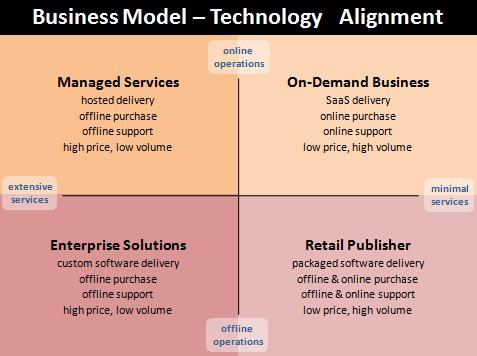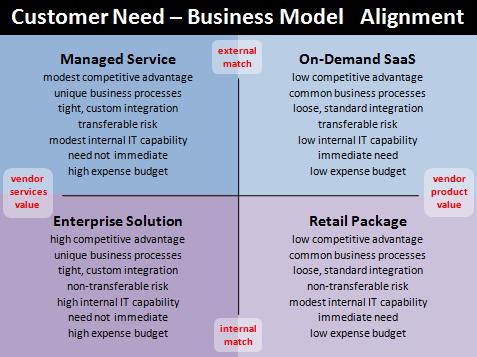Since it’s inception, software-as-a-service has labored under an identity crisis. What truly distinguishes SaaS from software? How should it be priced, sold and serviced? Is it possible to succeed with a hybrid approach where a vendor offers both SaaS and software versions of a product? Recently, Jeff Kaplan reported that Google will be offering Gmail as an installed service–flying in the face of the current conventional wisdom that SaaS players should stay true to their model. Alternatively, Oracle is finally making a serious challenge to salesforce.com with its Oracle CRM OnDemand (I know because their sales reps keep calling me, but I’m still not buying it).
What does it all mean?
First and foremost I would like to say that IF YOU ARE A STARTUP, it doesn’t matter if you are offering enterprise software, B2B software-as-a-service, online games, or even hardware—STICK TO ONE BUSINESS MODEL!!! Handling multiple business models almost always entails increased organizational complexity and heightened internal politics. It is often essential to separate organizational functions (e.g., sales, marketing, engineering, etc.) or even entire P&Ls (e.g., divisions, spin-offs, etc.) in order to achieve the right cost structure and culture required to be successful in each line of business. In short, it is death to a severely resource constrained company.
The most common software technology distribution models arise naturally from the economics of information goods. Computer software does three basic things: copies data, transforms data, and moves data. But, the unique thing about software (unlike hardware) is that it just happens to be made up of data itself. Why is this important? Because the costs of copying, transforming and moving data around is decreasing everyday, and in many circumstances it is economically equivalent to zero. This is why so many Internet applications are free! The more a software application lends itself to this sort of self-referential automation, the lower it’s cost. Pretty theoretical, so here it is in plain English. Custom applications are hard to deploy (copy and transform) and fat or data-intensive applications are hard to deliver over the Internet (move). And, here is the picture.

How costs give rise to different software distribution models.
The more you can align your business model with the underlying economics of the technology, the better off your will be. Perfect alignment is rarely achievable, because your customers will pull your business in one direction, while your technology will pull it in another. So, choose your customers and your technologies wisely! However, here is how the most common software business models line up with the technology choices above.

Aligning the business with the technology distribution model
increases competitive advantage and profitability.
Now let’s say you’ve done everything right. You’ve built it, but will customers come? Ultimately, it is the alignment between your offering and your customers’ needs that should determine your business model. Even if you follow all the Top Ten Dos and Don’ts of SaaS, if you offer an on-demand product that no one wants to buy or use over the Internet, then you still have a clear recipe for failure. Alternatively, selecting the approach that best fits your customers’ needs, but then failing to execute cleanly on key business or technical dimensions of your chosen model can lead to an inferior competitive position and poor profitability. Success depends on first choosing the right customers, then choosing the right business model for those customers and finally achieving coherent alignment between your customers, your business and your technology.

Short list of customer needs that align well with each respective business model,
e.g., Does the customer’s business derive competitive advantage from the application?
Does the application automate a process unique to the customer?
Can the customer transfer risk associated with the application to the vendor? etc.
Confusion usually arises when you start with the technology, but it doesn’t align coherently with your chosen business approach or your chosen customers, i.e., we have this cool new technology, let’s find someone who needs it, and then see if we can get them to pay for it. It’s OK to start with the technology first, that is the nature of innovation, but the customer need and business model economics should be vetted prior to writing a single line of code if you want to maximize your chances of success. But, it’s usually a lot clearer when you can start with the customer need and work your way back to the right business and technical approach.
Finally for the SaaS and software zealots alike. As the costs of data replication, transformation and distribution continue to decrease, the technological pressure to move everything online will become more and more irresistible. But, when customer needs are intractably unique, risky and complex, on-site software will remain the preferred alternative.
The method of revenue growth in SaaS is one of the most appealing aspects of the business. Software of the past consisted of a customer making a one-time purchase of a disk and then installing software on a desktop. SaaS entails customers continually purchasing access to a service to access the desired software.
Lean plans are best for companies and startups who are in earlier stages of development or who plan to change their product on a regular basis. For some SaaS startups, this plan often leaves more room to accommodate for different product lines, packages, and changes that will eventually happen over time.
This was a very interesting post, with some helpful “live by” rules. So often it is easy to focus too heavily on the technology and innovation, while losing sight of the exact relation to customer need and business economics. As you say, perfect alignment is rarely achievable, so it is important to constantly reexamine the alignment of the three components (customer need, business model, technology.) For those working to create a SaaS business model, here is a helpful post with slides that walk through the steps to creating a successful model: http://www.forentrepreneurs.com/saas-business-models-slide-deck/
[…] The SaaS Hybrid Question – Demystifying Software Business Models | Chaotic Flow by Joel York (tags: saas ondemand model hybrid) Share and Enjoy: […]
Kent,
Great question. This analysis is about the alignment between the technology, the business model and the customer based on the assumption that when they are well aligned the business thrives, and when they are not the business will struggle. Well, all businesses struggle. The comment in the post perfect alignment is rarely achievable, because your customers will pull your business in one direction, while your technology will pull it in another is particularly applicable to your situation.
I think the solution is to focus on how you (and your customers) define your business, not your technology. From what you describe, it is not certain that you are in the hosted quadrant vs. the SaaS quadrant. If your technology is multi-tenant SaaS and standard for all customers, then that is what it is. But, if your customers want you to be a managed services business, i.e., high human services, customer-specific customization to your product, delivered online, and they are willing to pay extra for all these things, then you will do best to follow their lead.
Cheers,
JY
I have read your post several times. Its got me thinking, but I am not sure exactly how…one of those states of confusion that preceeds enlightenment (hopefully).
My big SaaS product is for the environmental data management. I built the concept when working for corporate America, saved the company $1.2 million a year, and realized I could do it for other companies.
My monthly fees I charge for this software are not cheap ($1500-$5000/month), but the ROI is less than 12 months (spend $50,000 to save $500,000), depending on the size of the customer.
This all sounds great if I had 100 customers, but I have less than 5. This is a technical multi step sale to big companies and government agencies, and I have been thinking it takes a while to make this happen.
However, your post has me wondering about alignment with my prospective customers. According to your chart, I am really in the managed hosting quadrant and not the SaaS quadrant. I am not sure what they means yet, but I will certainly be giving it some thought.
Thanks for sharing your ideas.
Good Article You have provided answers to many questions, CEO’s, CFO’s and CIO’s are asking in these tough economic times